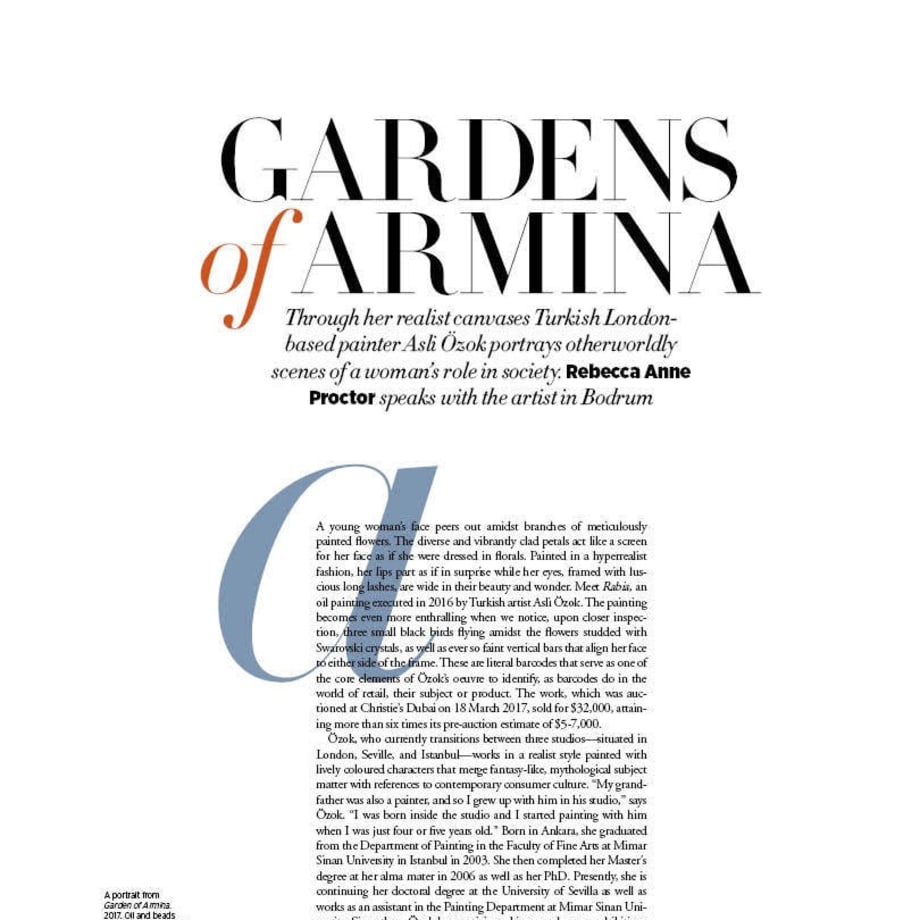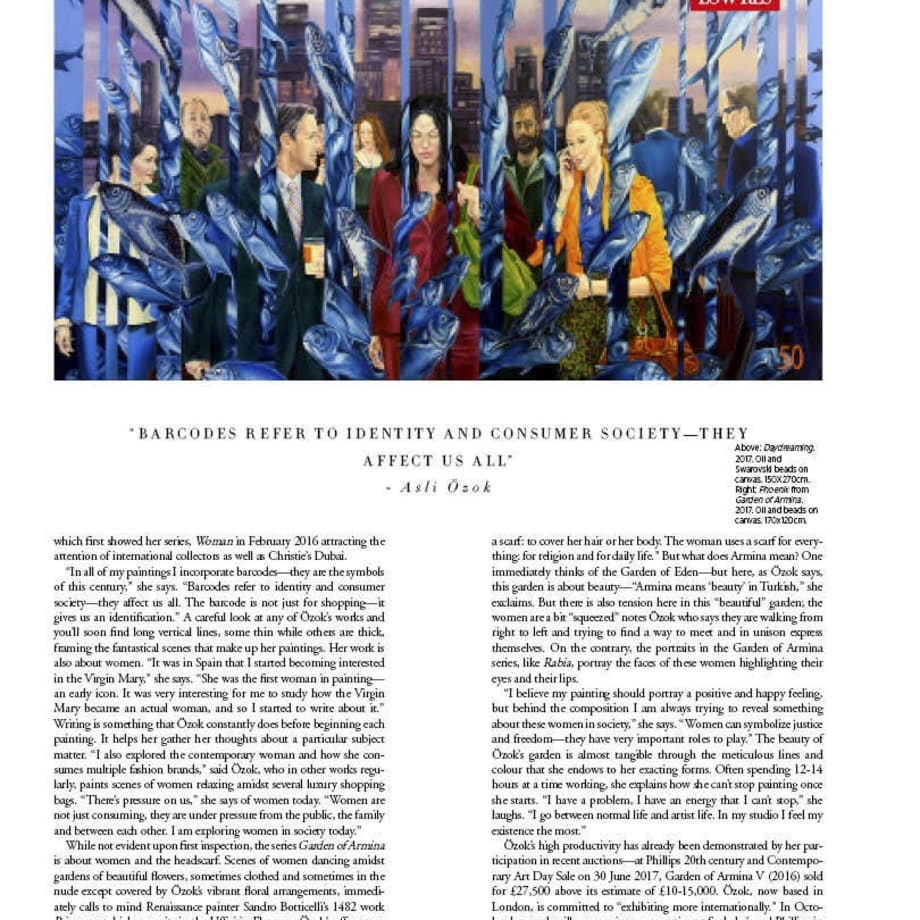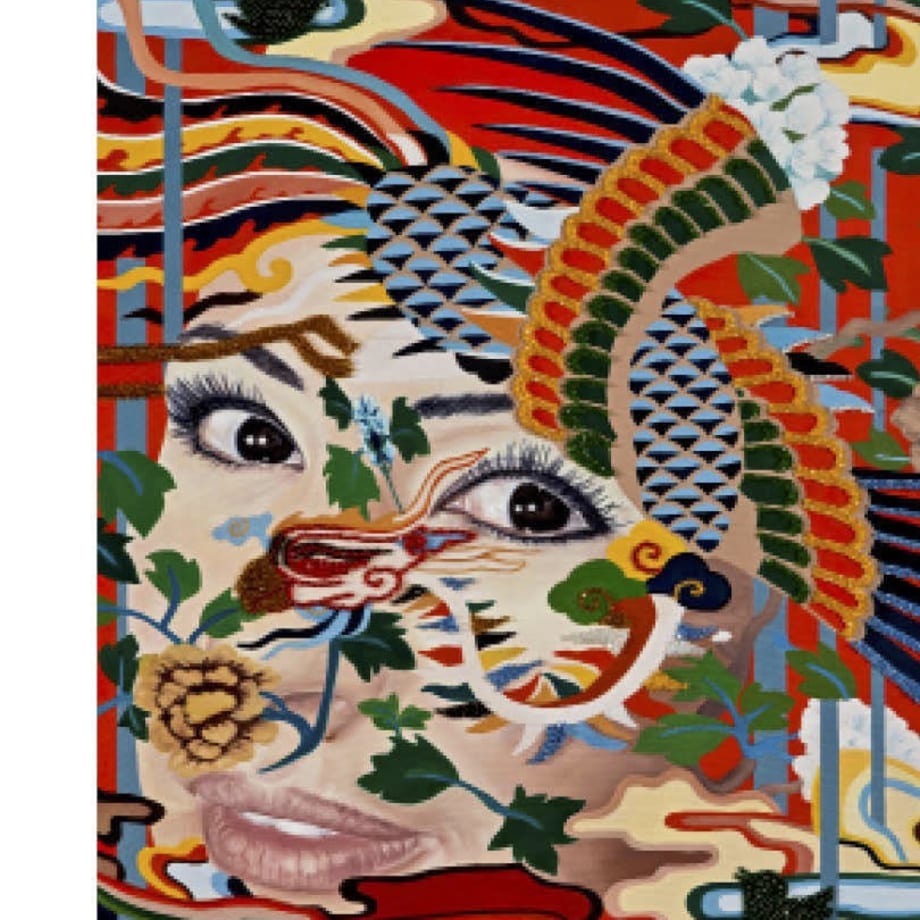Through her realist canvases Turkish London- based painter Asli Özok portrays otherworldly scenes of a woman's role in society. Rebecca Anne Proctor speaks with the artist in Bodrum.
A young woman's lace peers out amidst branches of meticulously painted flowers.The diverse and vibrantly clad petals act like a screen for her face as if she were dressed in florals. Painted in a hyperrealist fashion, her lips part as if in surprise while her eyes, framed with luscious long lashes, are wide in their beauty and wonder. Meet Rabia, an oil painting executed in 2016 by Turkish artist Asli Özok. The painting becomes even more enthralling when we notice, upon closer inspection, three small black birds flying amidst the flowers studded with Swarovski crystals, as well as ever so faint vertical bars that align her face to either side of the frame. These are literal barcodes that serve as one of the core elements of Özoks oeuvre to identify, as barcodes do in the world of retail, their subject or product. The work, which was auctioned at Christie's Dubai on 18 March 2017, sold for $32,000, attaining more than six times its pre-auction estimate of $5-7,000.
Özok, who currently transitions between three studios - situated in London, Seville, and Istanbul- works in a realist style painted with lively coloured characters that merge fantasy-like, mythological subject matter with references to contemporary consumer culture. My grandfather was also a painter, and so I grew up with him in his studio," says Özok. "I was born inside the studio and I started painting with him when I was just four or five years old." Born in Ankara, she graduated from the Department of Painting in the Faculty of Fine Arts at Mimar Sinan University in Istanbul in 2003. She then completed her Master's degree at her alma mater in 2006 as well as her PhD. Presently, she is continuing her doctoral degree at the University of Sevilla as well as works as an assistant in the Painting Department at Mimar Sinan University. Since then, Özok has participated in several group exhibitions and several international exhibitions, including in Istanbul, Sofia, Chisinau, Lisbon, Seville, Tokyo, Florence and Chicago. It was The Box in Busan, South Korea, in 2016, that first exhibited her series Garden of Arminia. In Istanbul, shes regulady exhibited with Galeri Merkur, which first showed her series, Woman in February 2016 attracting the attention of international collectors as well as Christie's Dubai.
"In all of my paintings I incorporate barcodes; they are the symbols of this century" she says. "Barcodes refer to identity and consumer society- they affect us all. The barcode is not just for shopping, it gives us an identification." A careful look at any of Özok’s works and you’ll soon find long vertical lines, some thin while others are thin. Her work is also about women." It was in Spain that I started becoming interested in the Virgin Mary" she says. "She was the first woman in painting- an early icon. It was very interesting for me to study how the Virgin Mary became an actual woman, and so I started to write about it.” Writing is something that Özok constantly does before beginning each painting. It helps her gather her thoughts about a particular subject matter. “I also explored the contemporary woman and how she consumes multiple fashion brands," said Özok, who in other works regularly paints scenes of women relaxing amidst several luxury shopping bags. "There's' pressure on us", she says of women today. "Women are not just consuming, they are under pressure from the public, the family and between each other. I am exploring women in society today."
While not evident upon first inspection, the series Garden of Armina is about women and the headscarf. Scenes of women dancing amidst gardens of beautiful flowers, sometimes clothed and sometimes in the nude except covered by Özok's vibrant floral arrangements, immediately calls to mind Renaissance painter Sandro Botticelli's 1482 work Primavera which now sits in the Uffizi in Florence. Özok’s offers contemporary likeness to the work of the Renaissance master. "In the Garden of Amina you cannot see the women's faces," she explains. "They are all anonymous.The flowers are metaphors for the beads that decorate the border of a woman's scarf. In every condition, a woman can use a scarf: to cover her hair or her body The woman uses a scarf for everything for religion and for daily life." But what does Armina mean? One immediately thinks of the Garden of Eden- but here as Özok says, this garden is about beauty-"Armina means beauty in Turkish." she exclaims, But there is also tension here in this "beautiful" garden; the women are a bit "squeezed" Özok notes who says they are walking from right to left and trying to find a way to meet and in unison express themselves. On the contrary, the portraits in the Garden of Armina series, like Rabia, portray the faces of these women highlighting their eyes and their lips.
"I believe my painting should portray a positive and happy feeling, but behind the composition I am always trying to reveal something about these women in society,” she says. "Women can symbolize justice and freedom- they have very important roles to play." The beauty of Özok's garden is almost tangible through the meticulous lines and colour that she endows to her exacting forms. Often spending 12-14 hours at a time working, she explains how she can't stop painting once she starts. "I have a problem, I have an energy that I can't stop," she laughs. "I go between normal life and artist life. In my studio I feel my existence the most."
Özok’s high productivity has already been demonstrated by her participation in recent auctions- at Phillips 20th century and Contemporary Art Day Sale on 30 June 2017, Garden of Armina V (2016) sold for £27,500 above its estimate of £10-15,000. Özok, now based in London, is committed to "exhibiting more internationally:" in October her work will once again go on auction at Sothebys and Phillips in London. I*see my paintings in my mind and I need to draw it and write it," says Ozok. "And then it comes very naturally. My painting is not just an illustration- I don't try and say something directly, but it is there- there's always another meaning. My painting is me.”



